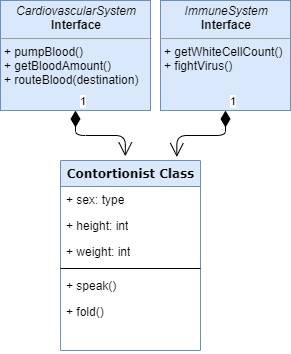Composition has always had some advantages over inheritance. Creating deep inheritance hierarchies leads to brittle/inflexible code when you are trying to make changes deep in the hierarchy.
There have been two key improvements made to interfaces in Java 8 and above, that make the argument for composition even stronger:
- Default methods - This allows you to define methods with a default implementation inside of interfaces. Classes that implement the interface can choose to override default methods or keep them as is.
- Private/Static methods - In this way, it becomes easier to write default functionality for an interface using private helper methods that should not be exposed as part of the interface.
Let's look at an example where we can use composition along with the new functionality of interfaces.
Building a Human with composition
Let's create a class that will represent a biological human. We can imagine that a human being is composed of many different systems that work together in order for the human to function. There's the skeletal system, cardiovascular system, immune system, nervous system, and so on.
In this oversimplified example, we can think of each system as being an interface. Our human class will implement each of these interfaces:
Great! Now, what if we want to create a new biological organism that shares a lot of traits with humans, but doesn't have a skeletal system? This illustrates the major advantage of composition. We can do this by simply creating a new class that implements only 2 out of the 3 systems:
Using default and private methods
Now we can write a simple skeletal system interface and see how a human might implement it. We will demonstrate private and default interface methods, as well as interface fields:
public interface SkeletalSystem {
List<Bone> bones = new ArrayList<>();
List<Joint> joints = new ArrayList<>();
abstract String getSex();
default void addBone(Bone b) {
bones.add(b);
recalculateJointHealth();
}
default void addJoint(Joint j) {
joints.add(j);
recalculateJointHealth();
}
default int getBoneMass() {
return bones.stream().map(Bone::getMass).reduce(0, Integer::sum);
}
private void recalculateJointHealth() {
for(Joint j : joints) {
//... do something
}
}
public class Bone {
private String name;
private int mass;
public Bone(String name, int mass) {
this.name = name;
this.mass = mass;
}
public int getMass() { return mass; }
public void setMass(int mass) { this.mass = mass; }
public String getName() { return name; }
public void setName(String name) { this.name = name; }
}
public class Joint {
private Bone b1;
private Bone b2;
private int strength;
public Joint(Bone b1, Bone b2, int strength) {
this.b1 = b1;
this.b2 = b2;
this.strength = strength;
}
public Bone getB1() { return b1; }
public void setB1(Bone b1) { this.b1 = b1; }
public Bone getB2() { return b2; }
public void setB2(Bone b2) { this.b2 = b2; }
public int getStrength() { return strength; }
public void setStrength(int strength) { this.strength = strength; }
}
}
For brevity, SkeletalSystem is presented as a fully self-contained interface. It defines the Bone and Joint classes and collections for storing them. There are default methods for adding bones and joints, as well as private helper methods.
public class Human implements SkeletalSystem {
private final String sex;
private int height;
private int weight;
public Human(String sex) {
this.sex = sex;
Bone lfemur = new Bone("LFemur", 50);
Bone lHip = new Bone("lHip", 50);
addBone(lfemur);
addBone(lHip);
addJoint(new Joint(lfemur, lHip, 100));
System.out.println(getBoneMass());
}
public int getHeight() { return height; }
public void setHeight(int height) { this.height = height; }
public int getWeight() { return weight; }
public void setWeight(int weight) { this.weight = weight; }
@Override
public String getSex() { return sex; }
}
Our Human class defines it's own data fields and uses the SkeletalSystem to add some bones and joints. We could also create helper methods that could initialize the SkeletalSystem using a standard human bone structure.
Conclusion
I hope this example will help you choose composition over inheritance when it's appropriate. Rember this basic rule when deciding:
- Choose inheritance when modeling a "is-a" relationship.
- A senior citizen is a citizen.
- A standing desk is a desk.
- Choose composition when modeling a "has-a" relationship.
- A human has a skeletal system, cardiovascular system, etc.
- A car has an engine, a transmission, gas tank, etc.








Top comments (0)